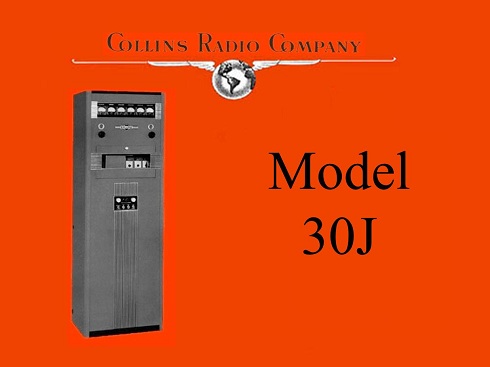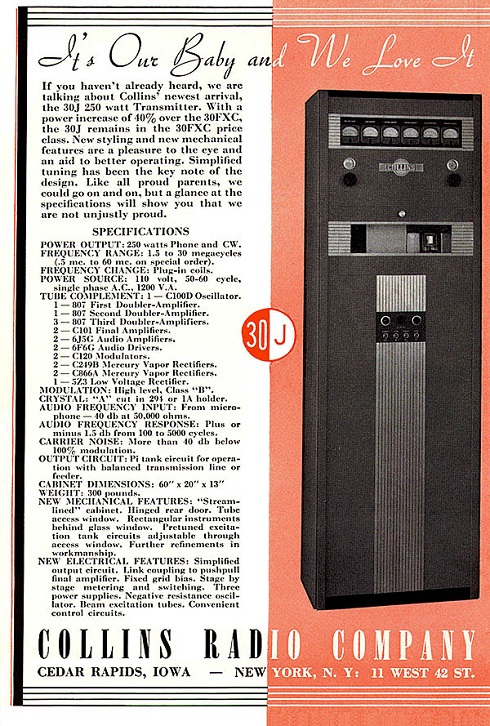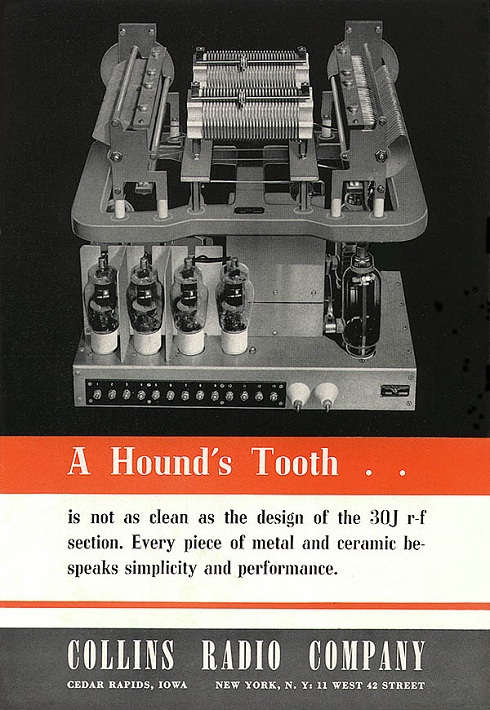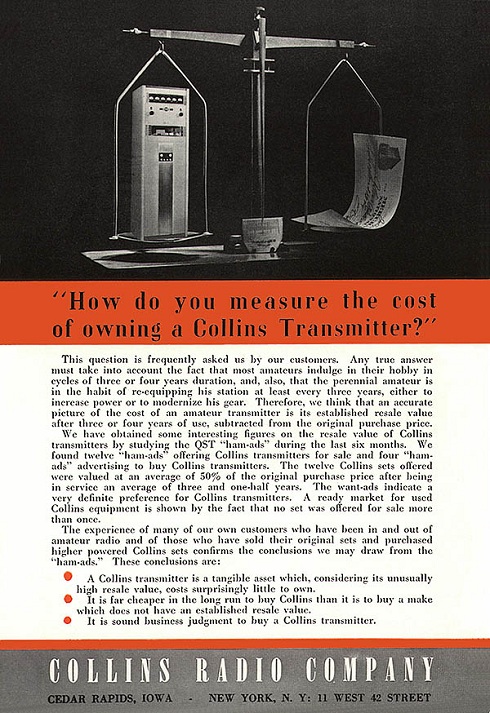30J Transmitter
COPYRIGHT 2012 CCA
Perhaps the Crown Jewel of the prewar Collins transmitters, the elegant 30J was the last amateur transmitter produced before Collins restructured for the war effort.
The 30J was a general purpose transmitter “designed for general applications such as police service, aeronautical ground stations, or general purpose point-to-point communications where service is intermittent.” Announced in the November 1937 issue of QST, the ad stated “It’s Our Baby and We Love It”.
The 30J was 40% more powerful than its predecessor, the 30FXC, rated at 250 watts out on phone and CW. Two basic model types were built, differing mainly in the tube lineups.
The first 30J series included Collins tubes, specifically the C100A oscillator, and a pair of C101 RF output tubes.
The RF deck underwent a complete redesign. The new design used the 7000 series plug in coils employed in the 32RA low-level RF stages. The driver stage, a pair of 807′s, used a plug-in shielded box to house its tank coils.
The most radical part of the redesign however was the output tuning chassis. Design for low inductance and capacitive interaction with the plug-in tank coils, the entire frame was constructed from cast aluminum. It was mounted directly above the RF deck and provided easy access to plug-in coils, which were wound on 2.5″ by 6″ coil forms.
The standard output was balanced, but a phasing coil option could be added to convert the output to unbalanced.
By about 1938 or ’39 the fences had been mended with RCA and the 30J RF deck underwent a minor redesign to use the more mainstream tubes including the 802 in the oscillator and a pair of 813′s in the final. This model was designated the 30J-18.
The 30J-18 used an 802 crystal oscillator stage feeding either an 807 frequency multiplier, or a pair of 807 buffers (selectable), which drove the push-pull 813s. The modulators were a pair of ZB120s, similar to 838s but zero-bias. Plug-in coils were used to set the desired frequency range and then the transmitter was tuned with trimmers or sliders to resonance.
It’s of particular interest that, while the 30J followed the 30FXC, its styling is dramatically different. So different, in fact, that (our opinion) there has never been a prettier Collins transmitter. Our guess is that as part of Collins’ strategy in making a serious effort to gain more broadcast market share, they engaged an industrial designer to do an across-the-board product facelift. The 30J was in the right place at the right time. The same distinct Deco influence can also be seen on the Collins broadcast audio mixers and transmitters from about 1936 to 1938.
The unit measures 60″ high, 20″ wide, and 13″ deep and weighs 386 pounds. It was finished in a St. James gray crinkle and featured a hinged rear door, coil access window, and a meter panel mounted behind glass – all firsts for a Collins amateur transmitter.
Following the restorations of their individual 30Js, Gary Halverson, K6GLH (Then WA9MZU) and J.B. Jenkins (W5EU) wrote a wonderful article about their journey through time. Click below to read about this great work.
The Collins 30J Series Amateur Transmitters – A Restoration Journey……..
……Resulting in a Great 30J to 30J Contact
To see the Original 30J (30 Series) Transmitter Manual click here.
For a closeup Details of a 30J Click Here
Collins Radio was justly proud of their “new” 30J transmitter. Following are the QST ads run during the production of this unit.
QST Intro Ad, November, 1937
QST, February of 1938
QST, March of 1938
QST, July of 1938
QST, September of 1938
If you have read all of this and you are not looking for a 30J, you need to see a doctor. You are sick.
– – – – – – – – CCA – – – – – – – –
Note: The images and text used in these pages are copyright 2012 protected, are restored and written by the Collins Collectors Association or its representatives, and may not be used in any other commercial or website applications. They may be downloaded and used privately – not for publication or internet use.
- CCA COLLINS HISTORICAL ARCHIVES
- The Pre War Years
- 150 Series Transmitter
- 2A, 2B AND 2C TUNERS (ATU)
- 30FX Transmitter
- 30FXB Transmitter
- 30FXC Transmitter
- 30FXR Transmitter
- 30J Transmitter
- 30W Transmitter
- 32 A/B Transmitter
- 32F Transmitter
- 32G Transmitter
- 40A/B Transmitter
- 45A Transmitter
- 4A Transmitter
- Bulletin 100
- Bulletin 101
- Bulletin 105
- Bulletin 200
- Bulletin 200A
- The Lost Decade
- The War Years
- Post War Broadcast / Commercial
- The Black Boxes
- The Grey Boxes
- The “S” Word or Solid State







